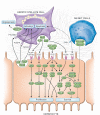Fibrosis-dependent mechanisms of hepatocarcinogenesis
- PMID: 22378017
- PMCID: PMC4087159
- DOI: 10.1002/hep.25670
Fibrosis-dependent mechanisms of hepatocarcinogenesis
Abstract
Hepatocellular carcinoma (HCC) is a rising worldwide cause of cancer mortality, making the elucidation of its underlying mechanisms an urgent priority. The liver is unique in its response to injury, simultaneously undergoing regeneration and fibrosis. HCC occurs in the context of these two divergent responses, leading to distinctive pathways of carcinogenesis. In this review we highlight pathways of liver tumorigenesis that depend on, or are enhanced by, fibrosis. Activated hepatic stellate cells drive fibrogenesis, changing the composition of the extracellular matrix. Matrix quantity and stiffness also increase, providing a reservoir for bound growth factors. In addition to promoting angiogenesis, these factors may enhance the survival of both preneoplastic hepatocytes and activated hepatic stellate cells. Fibrotic changes also modulate the activity of inflammatory cells in the liver, reducing the activity of natural killer and natural killer T cells that normally contribute to tumor surveillance. These pathways synergize with inflammatory signals, including telomerase reactivation and reactive oxygen species release, ultimately resulting in cancer. Clarifying fibrosis-dependent tumorigenic mechanisms will help rationalize antifibrotic therapies as a strategy to prevent and treat HCC.
Copyright © 2012 American Association for the Study of Liver Diseases.
Figures


References
-
- Shariff MI, Cox IJ, Gomaa AI, Khan SA, Gedroyc W, Taylor-Robinson SD. Hepatocellular carcinoma: current trends in worldwide epidemiology, risk factors, diagnosis and therapeutics. Expert Rev Gastroenterol Hepatol. 2009;3:353–367. - PubMed
-
- El-Serag HB. Epidemiology of hepatocellular carcinoma in USA. Hepatol Res. 2007;37(Suppl 2):S88–94. - PubMed
-
- Schutte K, Bornschein J, Malfertheiner P. Hepatocellular carcinoma--epidemiological trends and risk factors. Dig Dis. 2009;27:80–92. - PubMed
Publication types
MeSH terms
Grants and funding
LinkOut - more resources
Full Text Sources
Other Literature Sources
Medical
